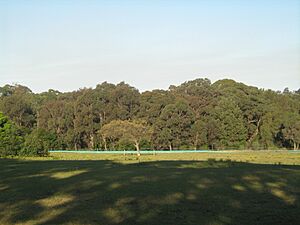Sydney Turpentine-Ironbark Forest facts for kids

The Sydney Turpentine-Ironbark Forest (STIF) is a special type of forest found in Sydney, New South Wales, Australia. It's one of six main native forest types in the area. Sadly, it's also one of the most endangered.
Only about 0.5% of this forest is left compared to before European settlement. Because of this, the New South Wales government has listed it as "Endangered." The Australian Government has also called it a "Critically Endangered Ecological Community." This means it's in great danger of disappearing forever.
Contents
What Makes This Forest Special?
Sydney Turpentine-Ironbark Forest has tall trees, usually 20–30 metres high. The ground is covered with beautiful flowering shrubs and native grasses. This forest grows best in rich clay soil that comes from shale rock. It likes gently rolling hills and a good amount of rain.
You won't find this forest in very dry areas or on high, rainy ridges. It also avoids sandy soils that aren't as fertile.
Main Trees of the Forest
The most important trees in this forest are the Turpentine (Syncarpia glomulifera) and several kinds of Ironbark trees. Turpentine trees can grow over 30 metres tall! The types of Ironbark trees can change depending on the local conditions.
Common Ironbark trees include Grey Ironbark (Eucalyptus paniculata) and Narrow-leaved Ironbark (Eucalyptus crebra). You might also see Red Ironbark (Eucalyptus fibrosa) and Grey Gum (Eucalyptus punctata).
Smaller Plants and Flowers
Below the tall trees, you'll find many other plants. These include wattles like Parramatta Green Wattle (Acacia parramattensis) and Sydney Golden Wattle (Acacia longifolia). The Common Hop Bush (Dodonaea triquetra) is also found here.
The forest floor is home to native grasses, herbs, and flowers. Some examples are Kangaroo Grass (Themeda australis) and Australian Bluebell (Wahlenbergia gracilis).
Overall, this forest can have more than 70 different plant species. However, smaller patches of the forest might have fewer types of plants. Some plant seeds might even wait underground for the right weather to grow.
Where Can You Find This Forest?
The Sydney Turpentine-Ironbark Forest naturally grows only in the Sydney area. It prefers places with deep clay soils. These soils come from Wianamatta shale or shale layers found within Hawkesbury sandstone. It grows on hills and plateaus.
Most of what's left of this forest is in the City of Ryde area. It used to be the main type of forest there. This forest also grew in clay soils over sandstone in the Hornsby Shire and in Sydney's inner-west. It needs about 900 to 1,000mm of rain each year.
Why So Little Left?
The land where Sydney Turpentine-Ironbark Forest grows is very fertile. This made it attractive for early European settlers. Much of the forest was cut down for its timber. Then, the land was used for farming. Today, many of these areas are covered by suburban homes.
Remaining Forest Patches
Very few parts of the Sydney Turpentine-Ironbark Forest still exist. The largest untouched area is the Wallumatta Nature Reserve in North Ryde. This reserve is protected by the National Parks and Wildlife Service.
Smaller pieces of the forest can be found in other places:
- Stewart Park in Marsfield.
- The grounds of Macquarie University.
- Meadowbank Park in Meadowbank.
- Newington Forest near Sydney Olympic Park in Homebush.
In the early 1990s, the Concord Local Council started a project to bring back STIF bushland in Queen Elizabeth II Park. This project is still going strong with the help of the new Canada Bay City Council and local volunteers. Another important area is in the Dame Eadith Walker Reserve at the Yaralla Estate in Concord West.
Scattered bits of this forest have also been found in many other local areas. Even a single tree from a STIF species can be important in a city. These small fragments are vital for genetic diversity. They can provide seeds for future restoration projects.
Ryde City Council knows how close this forest is to disappearing. If a tree needs to be removed, the council asks that a new tree from the original STIF species list be planted. They also encourage local residents to plant native trees, shrubs, and ground covers from the Sydney Turpentine-Ironbark Forest in their own gardens.
Images for kids
-
Entrance to Wallumatta Nature Reserve, North Ryde.
-
Wallumatta Nature Reserve, North Ryde.
-
Tree canopy at Wallumatta Nature Reserve, North Ryde.






